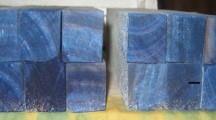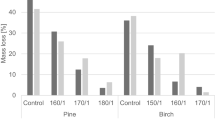Abstract
The aim of this study was to investigate whether making incising for injecting alkaline copper quaternary (ACQ) into wood extends the wood’s biodeterioration resistance. The biodeterioration resistance was checked by comparing long-term residual ACQ in wood with a toxic threshold to fungi. The residual ACQ in wood was estimated by leaching ratios and a long-term emission model which was derived by leaching tests of full-sized ACQ treated wood. The initial retention and the amount of ACQ leached of incised specimens were higher than those of non-incised specimens. However, the initial retention had a larger impact on leaching ratio than amount of ACQ leached. As a result, the leaching ratios of incised specimens were lower than those of non-incised specimens. The results indicate that incised wood can be expected to have the biodeterioration resistance for a longer period of time than non-incised wood.




Similar content being viewed by others
References
Archer K, Nicholas DD, Schultz TP (1995) Screening of wood preservatives: comparison of the soil-block, agar-block, and agar-plate tests. Forest Prod J 45:86–89
AWPA (2009a) A3-08 Standard method for determining penetration of preservatives and fire retardants. American Wood Protection Association, Birmingham
AWPA (2009b) A9-08 Standard method for analysis of treated wood and treating solutions by X-ray spectroscopy. American Wood Protection Association, Birmingham
Baines EF, Saur JM (1985) Preservative treatment of spruce and other refractory wood. Proc of Am Wood Preservers Assoc Conf 81:136–147
British Standard (BS) 8417 (2011) Preservation of wood. Code of Practice. British Standard online at techindex.co.uk. British Standard Institution
Brooks KM (1996) Evaluating the environmental risks associated with the use of chromated copper arsenate-treated wood products in aquatic environments. Estuaries 19(2A):296–305
Brooks KM (1997a) Literature review and assessment of the environmental risks associated with the use of ACZA treated wood products in aquatic environments. 2nd edn. Prepared for the Western Wood Preservers’ Institute, Vancouver
Brooks KM (1997b) Literature review, computer model and assessment of the potential environmental risks associated with creosote treated wood products used in aquatic environments. 3rd edn. Prepared for the Western Wood Preservers’ Institute, Vancouver
Brooks KM (1997c) Literature review and assessment of the environmental risks associated with the use of CCA treated wood products in aquatic environments. 3rd edition. Prepared for the Western Wood Preservers’ Institute, Vancouver
Brooks KM (1998a) Literature review and assessment of the environmental risks associated with the use of ACQ treated wood products in aquatic environments. Prepared for the Western Wood Preservers Institute, Vancouver
Brooks KM (1998b) Literature review and assessment of the environmental risks associated with the use pentachlorophenol treated wood products in aquatic environments. Prepared for Western Wood Preservers Institute, Vancouver
Brooks KM (2000a) Assessment of the environmental effects associated with wooden bridges preserved with creosote, copper naphthenate or chromated copper arsenate. Res. Pap. FPL-RP-587. US Department of Agriculture, Madison (Forest Service, Forest Products Laboratory)
Brooks KM (2000b) Environmental impact of preservative-treated wood in a wetland boardwalk. Res. Pap. FPL-RP-582. US Department of Agriculture, Madison (Forest Service, Forest Products Laboratory)
Brooks KM (2002) Copper loss from copper naphthenate treated piling immersed in freshwater. Technical report produced for Merichem Company Research Center, Houston
Cooper PA (1973) Effect of species, precompression, and seasoning on heartwood preservative treatability of six western conifers. Forest Prod J 13:51–59
Cooper PA, Ross NA (1977) Treatability of western hemlock lumber from coastal and interior British Columbia regions with waterborne preservatives. Forest Prod J 27:36–39
Cooper PA, Ung YT (2003) Comparison of stabilization and leaching of CCA and ACQ treated lumber. Proc Canad Wood Preserv Assoc 24:177–185
Fleuren RHLJ (2006) Proposal for the interpretation of leaching study data for wood preservatives (biocides), RIVM report 601516014: 69–89
Freeman MH, Crawford D, Lebow P, Brient JA (2005) A comparison of wood preservatives in posts in southern Mississippi: results from a half-decade of testing. In: Proceedings, 101st conference. American Wood-Preservers’ Association, New Orleans La, May 15–17: 136∼143
Gjovik LE, Schumann DR (1992) Treatability of native softwood species of the northeastern United States. Res. Pap. FPL-RP-508. USDA Forest Serv., Forest Prod. Lab., Madison, WI
Hattori N (1995) Laser processing of wood. Mokuzai Gakkaishi 41:703–709
Hernandez R, Winandy JE (2005) Evaluation of a reduced section modulus model for determining effects of incising on bending strength and stiffness of structural lumber. Forest Prod J 55:77–83
Hingston JA (2002) Leaching of copper based preservatives in aquatic environments. Ph. D. Thesis. Faculty of Life Sciences, University of London, London, UK
Homan WJ, van Oosten AL (1999) Statistically stable models for determination of PEC. Int. Res. Group on Wood Preservation, Doc. IRG/WP, 99–50135
ICH Q2B Validation of Analytical Procedures (1996) Methodology (International Conference on Harmonization of Technical Requirements for Registration of Pharmaceuticals for Human Use), Geneva, Switzerland
Islam MN, Ando K, Yamuchi H, Kobayashi Y, Hattori N (2007) Passive impregnation of liquid in impermeable lumber incised by laser. J Wood Sci 53:436–441
Islam MN, Ando K, Yamuchi H, Kobayashi Y, Hattori N (2008) Comparative study between full cell and passive impregnation method of wood preservation for laser incised Doulas fir lumber. Wood Sci Technol 42:343–350
Kang SM, Park YS, Cho MW, Kim SK (2007a) Developing analytical methods for determination of quaternary ammonium compounds (DDAC) using HPLC-MS (application to treating solution and preservatives treated wood). Proceedings of the Korean society of wood science and technology annual meeting:85–86
Kang SM, Cho MW, Kim GH, Koo JA (2007b) Determination of quaternary ammonium compounds (DBAC, DDAC) using HPLC (application to treating solution, treated wood and leacheate). 2007 proceedings of the Korean society of wood science and technology annual meeting:263–264
Lebow S (1996) Leaching of wood preservative components and their mobility in the environment. Summary of pertinent literature. Gen. Tech. Rept. FPL-GTR-93. USDA Forest Serv., Forest Prod. Lab., Madison, WI
Lebow S, Lebow P, Foster D (2008) Estimating preservative release from treated wood exposed to precipitation. Wood Fiber Sci 40:562–571
Morrell JJ, Lebow ST (1991) Borate treatment of seasoned western hemlock and Douglas-fir lumber. Forest Prod J 41:27–29
Morrell JJ, Winandy JE (1987) Incising practices used to improve preservative treatment in western species: A preliminary survey. In: Proceeding of American Wood Preservers’ Assoc. Vol 83 AWPA, Granbury TX:400–404
Morris PI (1995) Pacific silver fir is the more-treatable component of hem-fir from coastal British Columbia. Forest Prod J 45:37–40
Morris PI, Morrell JJ, Ruddick JNR (1994) A review of incising as a means of improving treatment of sawnwood. Internat. Res Group on Wood Preservation Document No. IRG/WP/40019. IRG, Stockholm, Sweden
Nami Kartal S, Lebow ST (2002) Effects of incising on treatability and leachability of CCA-C-treated eastern hemlock. Forest Prod J 52:44–48
National Institute of Forest Science (NIFoS) notification No. 2016-2 (2016) Standard and specification of wood products. Seoul, Republic of Korea
Nejad M, Ung T, Cooper P (2012) Effect of coatings on ACQ preservative component distribution and solubility after natural weathering exposure. Wood Sci Technol 46:1169–1180
Núñez O, Moyano E, Galceran MT (2004) Determination of quaternary ammonium biocides by liquid chromatography – mass spectrometry. J Chromatogr A 1058:89–95
OECD (2013) Revised emission scenario document for wood preservatives. Organisation for Economic Co-operation and Development (OECD): Series on Emission Scenario Documents, vol 2. Paris, France
Paneli M (2001) Suggestions for calculation of the long term emissions of preservative component(s) from treated wood, based on experimental leaching data. Working document EXGP(2001)11 of the Expert Group for the development of the OECD ESD for Wood Preservatives, August 2001
Pang SJ, Hong JP, Lee JJ, Oh JK (2015) Service life estimation of ACQ-treated wood based on biodeterioration resistance. J Korean Wood Sci Technol 43:641–651
Pankras S, Cooper P, Ung T, Awoyemi L (2009) Effect of copper to quat ratio on fixation and leaching of preservative components in alkaline copper quat-treated wood. Forest Prod J 59:21–27
Pankras S, Cooper P, Ung T, Awoyemi L (2012a) Effect of ammonia addition to alkaline copper quaternary wood preservative solution on the distribution of copper complexes and leaching. Holzforschung 66:397–406
Pankras S, Cooper PA, Wylie S (2012b) Relationship between copper species in solution and leaching from alkaline copper quat (ACQ) treated wood. Holzforschung 66:505–514
Perrin PW (1978) Review of incising and its effects on strength and preservative treatment of wood. Forest Prod J 28:27–33
Republic of Korea Patent (2010) Publication No. 10–0942314. Measurement method for purity of didecyl-dimethyl-ammonium chloride using HPLC-MS
Rhatigan R, Freitag C, El-Kasmi S, Morrell JJ (2004) Preservative treatment of Scots pine an Norway spruce. Forest Prod J 54:91–94
Ruddick JNR (1991) Laser incising of Canadian softwood to improve treatability. Forest Prod J 41:53–57
Smith WB (1986) Treatability of several northeastern species with chromated copper arsenate wood preservative. Forest Prod J 36:63–69
Thevenon MF, Tondi G, Pizzi A (2009) High performance tannin resin-boron wood preservatives for outdoor end-uses. Eur J Wood Prod 67:89–93
Ung YT, Cooper PA (2005) Copper stabilization in ACQ-D treated wood: retention, temperature and species effects. Holz Roh Werkst 63:186–191
Van Eetvelde G, Stevens M, Vander Mijnsbrugge L (1994) Comparative study on leaching of CCA from treated timber: Modeling of emission data. Document No. IRG/WP 04-50027. International Research Group on Wood Protection
Waldron L, Cooper PA, Ung TY (2005) Prediction of long-term leaching potential of preservative-treated wood by diffusion modeling. Holzforschung 59:581–588
Winandy JE, Morrell JJ, Lebow ST (1994) Review of effects of incising on treatability and strength. In: Proceeding wood preservation in the ‘90 s and Beyond. Forest Prod. Soc., Madison, WI:65–69
Acknowledgements
This study was carried out with the support of ‘Forest Science & Technology Projects Project No. S121315L020120)’ provided by Korea Forest Service and ‘Post-doctoral research fellowship’ provided by National Institute of Forest Science (NIFoS).
Author information
Authors and Affiliations
Corresponding author
Rights and permissions
About this article
Cite this article
Pang, SJ., Oh, JK., Hong, JP. et al. Effect of incising on the long-term biodeterioration resistance of alkaline copper quaternary (ACQ) treated wood. Eur. J. Wood Prod. 75, 777–783 (2017). https://doi.org/10.1007/s00107-016-1151-x
Received:
Published:
Issue Date:
DOI: https://doi.org/10.1007/s00107-016-1151-x




